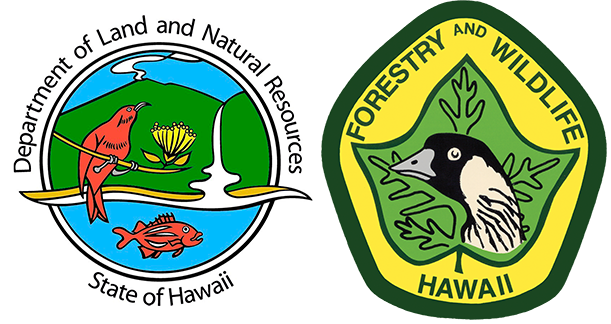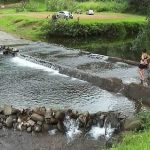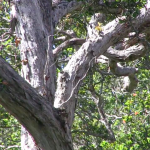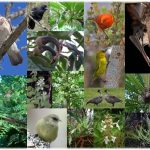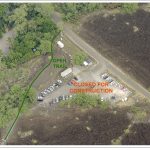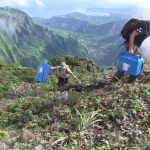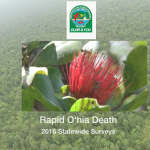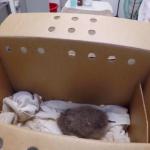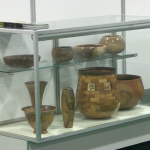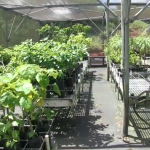LIHU‘E -- The community is invited to attend an information meeting about the project now underway to construct a bridge for vehicles and pedestrians to cross over Keahua Stream. This location is at the end of Kuamo‘o Road, at the Keahua Arboretum in the Lihu‘e-Koloa State Forest Reserve. The meeting will take place on Tuesday, November 29 from 5:30 to 7 p.m. at Kapa‘a Middle School, 4867 Olohena Rd.
featured
(Hamakua Coast, Hawai’i) - From the road, in the Laupahoehoe Section of the Hilo Forest Reserve, Steve Bergfeld of the Hawai’i Department of Land and Natural Resources spots the enormous, towering, ōhiʻa tree; its thick branches now completely without leaves. The Hawai’i Island Branch Manager for the DLNR Division of Forestry and Wildlife wants to get a close-up look at the tree, after a technician first spotted it and took samples a week ago. Two laboratory tests have confirmed that this very old tree was killed by the fast-moving fungal infection known as Rapid ʻŌhiʻa Death.
HILO, HAWAII -- The Department of Land and Natural Resources (DLNR) Division of Forestry and Wildlife (DOFAW) will hold a public hearing on Wednesday November 16 to receive testimony on the request of Kamehameha Schools for a 50-year Incidental Take License (ITL) from the Board of Land and Natural Resources for a Safe Harbor Agreement (SHA) for a 32,280-acre property located near Volcano Village on the island of Hawai‘i.
KAHULUI – Visitors to the ‘Ahihi-Kina‘u Natural Area Reserve and Keone‘oi‘o (La Perouse Bay) area are advised that renovation of the Kanahena parking area is expected to create limited parking and traffic delays from Monday, November 14 to January 15, 2017. The project involves improving the parking area surface and drainage with concrete paving at the current location which is away from the ocean. The paved surface will help prevent pollutants from vehicles from entering the surrounding environment.
(Click on image to watch video) Extraordinary Endangered Seabirds & Extraordinary Steps to Save Them Kauai Endangered Seabird Recovery Project Pacific Rim Conservation DLNR/Division of Forestry & Wildlife DLNR/Natural Area Reserve System American Bird… Read More »
(Honolulu) – A series of aerial surveys of six Hawaiian Islands reveals that the fungal disease, known as Rapid ʻŌhiʻa Death has impacted nearly 50,000 acres of native forest on the Big Island of Hawai‘i. That’s an increase of some 13,000 acres from surveys done earlier in 2016. “It’s important to note that the aerial surveys still need verification by conducting ground-truthing and lab tests,” said Philipp Lahaela Walter, State Resource & Survey Forester for the DLNR Division of Forestry and Wildlife (DOFAW). While some of the increase is due to expanding the survey area, much of it is due to new tree mortality.
(Honolulu) – You’ve probably seen them in their bright blue shirts out in the forest pulling weeds, planting native trees, restoring trails, or hiking up a mountain side. These are participants from Hawaii’s Youth Conservation Corps that are helping environmental agencies tackle today’s natural resource problems and care for Hawaii’s fragile ecosystems.
(Lihue, Kaua‘i) - A tiny Newell’s Shearwater chick, rescued from the Hono o Na Pali Natural Area Reserve on Kaua‘i, in late August, is thriving and doing well at the Save our Shearwaters (SOS) facility. The lost chick was collected by KESRP staff members, Heidi Ingram and John Hintze. They carried it up the side of a mountain to a helicopter landing zone on a remote ridge. The bird was put into a carry box and flown to Lihue where it was then taken to SOS at the Kaua‘i Humane Society.
(Honolulu) -- The Department of Land and Natural Resources and the IUCN’s Oceania Regional Office (ORO) are hosting the Hawaii-Pacific Pavilion during the IUCN World Conservation Congress 2016, which will take place at the Hawai‘i Convention Center from September 2-9.
(Honolulu) – When Silene perlmanii, an extremely rare small shrub with delicate white flowers, was discovered on O‘ahu by botanist Steve Perlman in 1987, just 20 individuals remained in the wild. Within three years, only 6 plants remained, dwindling to a single individual by 1994. The decline of this species at the last known wild site has been attributed to aggressive weeds and introduced ungulates damaging the habitat.
